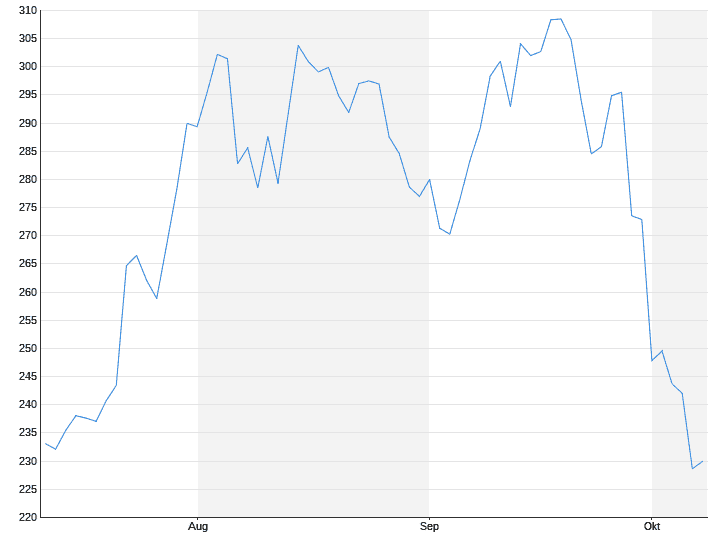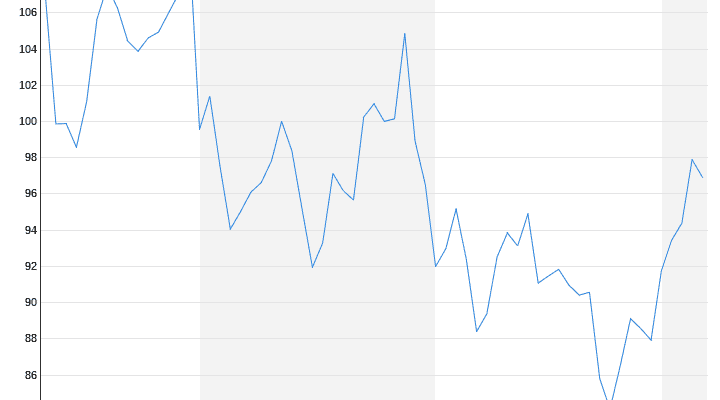Indices near yearly lows
Wall Street’s slide continues
10/10/2022, 10:45 p.m
The Russian rockets on major Ukrainian cities are creating a bad mood on Wall Street. All three indices remain close to their lows for the year. The fact that the major bank JP Morgen is pessimistic about the near future is increasing the pressure on prices.
After the sharp losses at the end of the week, Wall Street has again shown discounts after extremely volatile trading. However, prices recovered significantly from the daily lows after the Nasdaq indices had fallen to a year’s low. Prices had previously come under pressure after JP Morgan CEO Jamie Dimon warned on CNBC that the S&P 500 could fall another 20 percent.
“We expect much more volatility in markets for the remainder of the year as the inevitability of higher interest rates prevails and the economic fallout becomes more apparent,” said investment strategist Arthur Laffer Jr. of Laffer Tengler Investments. Of the Dow Jones Index lost 0.3 percent to 29,203 points – the daily low was around 200 points below. S&P 500 and Nasdaq Composite lost 0.7 and 1.0 percent respectively. 1,085 (467) course winners were recorded on the Nyse, they faced 2,094 (2,717) losers, while 112 (103) titles closed unchanged. Overall, sales remained low because of the “Columbus Day” holiday. While the stock market traded normally, the US bond market remained closed.
Overall, the three most important stock indices remained close to their lows for the year. Persistent concerns about sharp interest rate hikes coupled with fears of recession dominated trading – especially after Friday’s labor market data. Russia’s renewed airstrikes against civilian facilities in Ukraine are also causing unease, as they were almost unanimously classified as acts of terrorism. The danger of further military escalations is increasing because the West will probably react, it said. US President Joe Biden promised further military aid to Ukraine. Elsewhere reference was made to weak economic data from China. There was also reluctance to buy in the run-up to important inflation data in the USA and the minutes of the Fed meeting during the week.
Dollar continues to rise – oil prices with levies
The dollar extended Friday’s gains on rate speculation. The dollar index gained 0.3 percent. But according to the US job market report, the gains were limited, according to Commerzbank. On the one hand, this may have been due to the fact that the data was still within the expected range. On the other hand, the dollar had already risen significantly in the days before in the course of hawkish statements by numerous Fed members.
Oil prices showed clear levies – burdened by the weak China data. In addition, according to reports, the US plans to bring oil from the strategic reserve to the market. In the previous week, crude oil prices had risen more strongly with the Opec+ group’s cut in production. “Crude oil trends lower as Opec+ decision fades. In fact, we are seeing oil prices falling back to pre-cartel announcement levels as the reality of global recessions takes hold,” said Spartan analyst Peter Cardillo.
Gold prices fell 1.6 percent. The troy ounce moved just below the support area between $1,680 and $1,670. Stress factors are the prospect of further significant interest rate hikes by the US Federal Reserve and the strong dollar, it said.
Chip sector still under pressure

After AMD’s sales warning, the semiconductor sector remained under selling pressure. The chip sector in the S&P 500 slipped another 3.3 percent after being the intraday loser on Friday, down 5.9 percent. Traders pointed to new US government industry restrictions to hit China’s military. According to Nomura, global semiconductor shipments are expected to continue declining for the remainder of 2022 and early 2023. Analysts lowered their forecast for global chip shipments in 2023 by 12 percent. For the AMD stock was down another 1.1 percent after plunging nearly 14 percent on Friday.
the Tesla stock closed just in the red, showing relative strength. The electric car manufacturer set a delivery record in China in September. The competitor papers of ford (-6.4%) and General Motors (-3.3%) fell after UBS downgraded shares. For Merck & Co went up 3.5 percent. The US pharmaceutical company had achieved a clinical study success.
